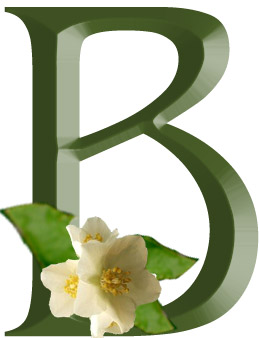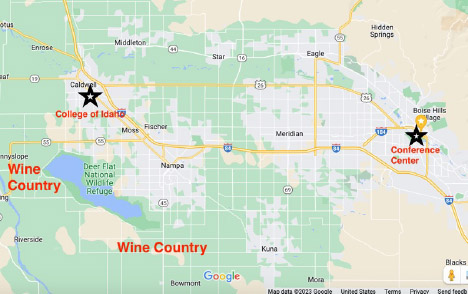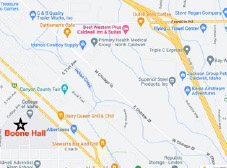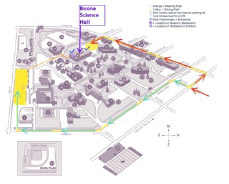

Interested in this adventure?
Sign up here:
OPEN HOUSE AT HAROLD M. TUCKER HERBARIUM (CIC) AND ORMA J. SMITH MUSEUM OF NATURAL HISTORY (CIDA)
AT THE COLLEGE OF IDAHO ON SATURDAY, JULY 22, 10:00-4:00.
Interested - Sign up here
We invite all Botany 2023 participants interested in examining the vascular plant holdings of The Harold M. Tucker Herbarium (CIC) and/or the paleobotanical collections of the Orma J. Smith Museum of Natural History (CIDA) to take advantage of an open house on Saturday, July 22, 10 am - 4 pm. Both the Herbarium and the Museum are in Boone Hall at The College of Idaho, a small private liberal arts college in Caldwell, Idaho, about half an hour’s drive west of the conference center in Boise (map below). Sorry, transportation will NOT be provided, but there is (usually) plenty of free parking at the College. The exhibit area and gift shop of the Museum will also be open (free admission), and a visit to Caldwell combines nicely with an on-your-own tour of southwest Idaho’s excellent wine country (e.g., Sunnyslope Wine Trail).
The Harold M. Tucker Herbarium is the oldest herbarium in southwestern Idaho, containing ca. 60,000 vascular plants primarily from southwestern Idaho and adjacent Oregon; for more information, contact director Robert Laport (rlaport@collegeofidaho.edu). There is also a small but significant collection of fungi by Ellen Trueblood, housed in the Museum. The other major regional herbarium, the Snake River Plains Herbarium (SRP) at Boise State University, does not have open hours planned but is within easy walking distance of the conference center; contact director Jim Smith for individual access (jfsmith@boisestate.edu). SRP holdings consist of ca. 97,000 vascular plants, lichens, fungi, and bryophytes from around the world, including many vouchers for the Flora of the World website of plant photos. Both CIC and SRP are fully digitized and accessible in advance of your visit via the Consortium of Pacific Northwest Herbaria, thanks to NSF funding initiated in 2011. The project also digitized specimens in numerous agency herbaria in southwestern Idaho and adjacent Oregon, including BBLM, BOIS, and VALE; access to specific specimens might be possible by special advance arrangement.
The paleobotany collections of the Orma J. Smith Museum of Natural History consist of an estimated 130,000 specimens, just starting to be catalogued and digitized. Miocene fossil floras in Idaho and adjacent Oregon represent the primary strength, with about 60% of the specimens from the middle Miocene Succor Creek flora. This is the only repository for the recently discovered Ponderosa and Paddock Reservoir paleofloras from central Idaho, among others, and we have accumulated what is now considered to be the second largest collection of Clarkia fossil plants. Contact senior paleobotany curator Patrick Fields (patrickffields@wowway.com) for more information.
The Museum as a whole is a relatively modest exhibit and research center that has been almost completely dependent on volunteers, but which was nevertheless included among the "30 Most Amazing Higher Education Natural History Museums" by Best College Reviews. In addition to paleobotany, research strengths include entomology and ichthyology; for more information, contact director Bill Clark (clarkfam1@mindspring.com). The Museum now also encompasses the Glen & Ruth Evans Gem & Mineral Collection, one of the largest in the West, that includes a particularly impressive selection of polished petrified wood, primarily from the western US. Note that the Museum exhibit area is also regularly open to the public Monday through Friday, 10:00 am – 3:00 pm.
For planning purposes, please let us know if you might be interested in visiting either the Harold M. Tucker Herbarium or the Orma J. Smith Museum of Natural History in Caldwell on July 22:
Fill out this google sheet with your interest



College of Idaho and Boone Hall from Exit 29/Franklin Rd from I-84 in Caldwell. Note that campus